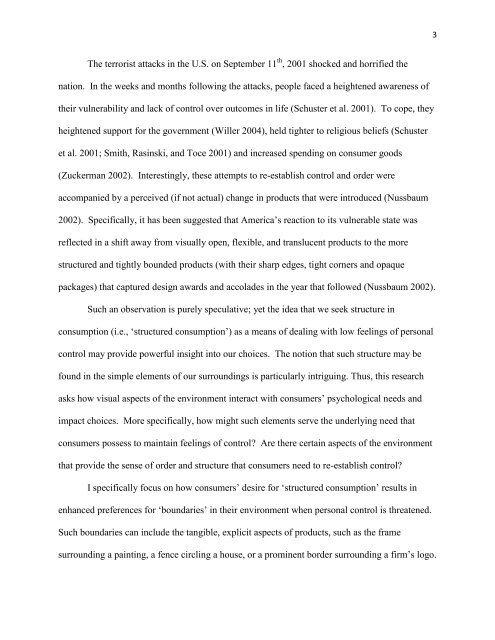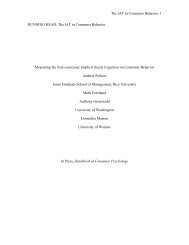The Beauty of Boundaries: When and Why We Seek Structure in ...
The Beauty of Boundaries: When and Why We Seek Structure in ...
The Beauty of Boundaries: When and Why We Seek Structure in ...
- No tags were found...
Create successful ePaper yourself
Turn your PDF publications into a flip-book with our unique Google optimized e-Paper software.
3<strong>The</strong> terrorist attacks <strong>in</strong> the U.S. on September 11 th , 2001 shocked <strong>and</strong> horrified thenation. In the weeks <strong>and</strong> months follow<strong>in</strong>g the attacks, people faced a heightened awareness <strong>of</strong>their vulnerability <strong>and</strong> lack <strong>of</strong> control over outcomes <strong>in</strong> life (Schuster et al. 2001). To cope, theyheightened support for the government (Willer 2004), held tighter to religious beliefs (Schusteret al. 2001; Smith, Ras<strong>in</strong>ski, <strong>and</strong> Toce 2001) <strong>and</strong> <strong>in</strong>creased spend<strong>in</strong>g on consumer goods(Zuckerman 2002). Interest<strong>in</strong>gly, these attempts to re-establish control <strong>and</strong> order wereaccompanied by a perceived (if not actual) change <strong>in</strong> products that were <strong>in</strong>troduced (Nussbaum2002). Specifically, it has been suggested that America‘s reaction to its vulnerable state wasreflected <strong>in</strong> a shift away from visually open, flexible, <strong>and</strong> translucent products to the morestructured <strong>and</strong> tightly bounded products (with their sharp edges, tight corners <strong>and</strong> opaquepackages) that captured design awards <strong>and</strong> accolades <strong>in</strong> the year that followed (Nussbaum 2002).Such an observation is purely speculative; yet the idea that we seek structure <strong>in</strong>consumption (i.e., ‗structured consumption‘) as a means <strong>of</strong> deal<strong>in</strong>g with low feel<strong>in</strong>gs <strong>of</strong> personalcontrol may provide powerful <strong>in</strong>sight <strong>in</strong>to our choices. <strong>The</strong> notion that such structure may befound <strong>in</strong> the simple elements <strong>of</strong> our surround<strong>in</strong>gs is particularly <strong>in</strong>trigu<strong>in</strong>g. Thus, this researchasks how visual aspects <strong>of</strong> the environment <strong>in</strong>teract with consumers‘ psychological needs <strong>and</strong>impact choices. More specifically, how might such elements serve the underly<strong>in</strong>g need thatconsumers possess to ma<strong>in</strong>ta<strong>in</strong> feel<strong>in</strong>gs <strong>of</strong> control? Are there certa<strong>in</strong> aspects <strong>of</strong> the environmentthat provide the sense <strong>of</strong> order <strong>and</strong> structure that consumers need to re-establish control?I specifically focus on how consumers‘ desire for ‗structured consumption‘ results <strong>in</strong>enhanced preferences for ‗boundaries‘ <strong>in</strong> their environment when personal control is threatened.Such boundaries can <strong>in</strong>clude the tangible, explicit aspects <strong>of</strong> products, such as the framesurround<strong>in</strong>g a pa<strong>in</strong>t<strong>in</strong>g, a fence circl<strong>in</strong>g a house, or a prom<strong>in</strong>ent border surround<strong>in</strong>g a firm‘s logo.




